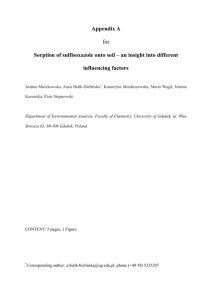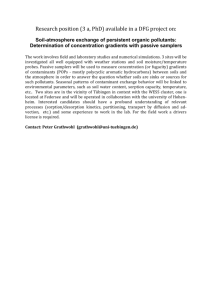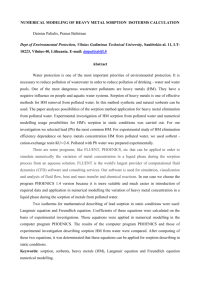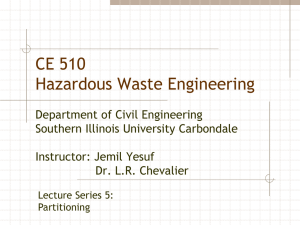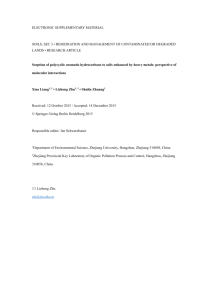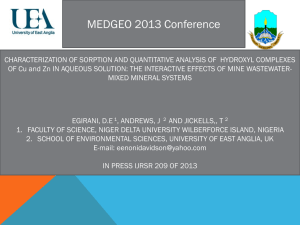CE 510 – Lecture 5 – Partitioning
advertisement
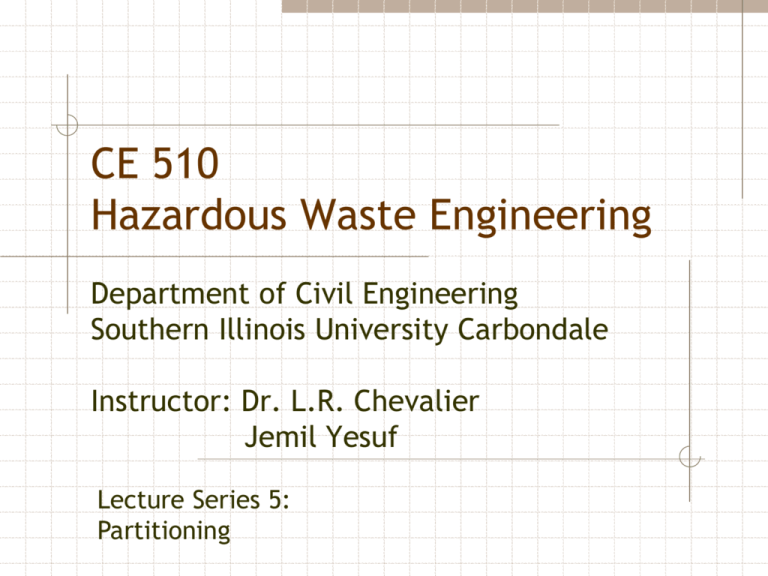
CE 510 Hazardous Waste Engineering Department of Civil Engineering Southern Illinois University Carbondale Instructor: Dr. L.R. Chevalier Jemil Yesuf Lecture Series 5: Partitioning Course Goals Review the history and impact of environmental laws in the United States Understand the terminology, nomenclature, and significance of properties of hazardous wastes and hazardous materials Develop strategies to find information of nomenclature, transport and behavior, and toxicity for hazardous compounds Elucidate procedures for describing, assessing, and sampling hazardous wastes at industrial facilities and contaminated sites Predict the behavior of hazardous chemicals in surface impoundments, soils, groundwater and treatment systems Assess the toxicity and risk associated with exposure to hazardous chemicals Apply scientific principles and process designs of hazardous wastes management, remediation and treatment Partitioning AIR WATER WATER SOLID WATER General phenomenon that describes tendency of contaminants to exist at equilibrium between phases BIOTIC Partitioning sorption WATER SOLID Accumulation of contaminants on or in the solid adsorption absorption Partitioning sorption WATER SOLID Sorbents include: Soils Sludges Hazardous waste containment material (clay liner) Granular activated carbon In hazardous waste, the solvent is generally water Factors of Sorption Properties of the sorbent, the sorbate and the liquid media Sorbent Hydrophobic Specific surface area Sorbate Hydrophobic Low water solubility Octanol-water partition coefficient, Kow Solvent Mostly water Air in emissions and unsaturated zone Sorption Mechanisms Exchange adsorption (ion exchange)– electrostatic due to charged sites on the surface. Adsorption goes up as ionic charge goes up and as hydrated radius goes down. Physical adsorption: Van der Waals attraction between adsorbate and adsorbent. The attraction is not fixed to a specific site and the adsorbate is relatively free to move on the surface. This is relatively weak, reversible, adsorption capable of multilayer adsorption. Chemical adsorption: Some degree of chemical bonding between adsorbate and adsorbent characterized by strong attractiveness. Adsorbed molecules are not free to move on the surface. There is a high degree of specificity and typically a monolayer is formed. The process is seldom reversible. Generally some combination of physical and chemical adsorption is responsible for activated carbon adsorption. Aqueous PhaseTransport in Soil C C C Bd C C DL 2 vx t x x t t rxn 2 dispersion * advection sorption reaction Bd = bulk density of the aquifer Θ = volumetric moisture content (porosity for saturated soils) C* = amount of solute sorbed per unit weight of solid rxn = subscript indicating a biological or chemical reaction of the solute, or radioactive decay (other than sorption) Aqueous Phase Transport in Soil C 2C C Bd C * C DL 2 vx t x x t t rxn C C C R DL 2 v x t x x 2 Properties of Soil Pre-regulatory hazardous waste disposal occurred in soils Need to review fundamental properties of soil Compared to aqueous and air systems, soils are heterogeneous composed of solid, liquid and gaseous phases Properties of Soil Organic 5% Air 20% Mineral Water 45% 30% Air Water Mineral Organic Properties of Soil Gravel 2.0-15 mm Sand 0.075-2.0 mm Silt 0.002-0.075 mm Clay <0.002 mm USDA Soil Particle Size Separates Relationship between soil class and particle size distribution Soil Triangle Calculator Class Example Determine the classification of the following: 22 % Sand , 42 % Silt , 36 % Clay 40 % Sand , 30 % Silt , 30 % Clay 60 % Sand , 30 % Silt , 10 % Clay 64 % Sand , 26 % Silt , 10 % Clay 46 % Sand , 30 % Silt , 24 % Clay Class Example Solution Soil Triangle Calculator Determine the classification of the following: 22 % Sand , 42 % Silt , 36 % Clay Clay Loam 40 % Sand , 30 % Silt , 30 % Clay Clay Loam 60 % Sand , 30 % Silt , 10 % Clay Sandy Loam 64 % Sand , 26 % Silt , 10 % Clay Sandy Loam 46 % Sand , 30 % Silt , 24 % Clay Loam How to Measure Sorption Batch experiments are conducted to determine the amount of solute removed varying the concentration of solute in solution varying the amount of soil The capacity of a solid to remove a solute is a function of the concentration of the solute How to Measure Sorption If the adsorbent and adsorbate are contacted long enough, an equilibrium will be established between the amount of adsorbate adsorbed and the amount of adsorbate in solution. The results of the experiment are plotted on a graph, called an isotherm Equilibrium sorption isotherm can be used when the sorption process is rapid compared to the flow velocity Kinetic sorption isotherm needed when the sorptive process is slow compared with the rate of fluid flow Equilibrium Sorption Isotherms Linear Sorption Isotherm Freundlich Sorption Isotherm Langmuir sorption Isotherm Equilibrium Sorption Isotherms Linear Sorption Isotherm C KdC C* * Kd 1 C C* = mass of solute sorbed per dry unit weight of solid (mg/kg) C = concentration of solute in solution at equilibrium with the solid (mg/L) Kd = distribution coefficient Linear Sorption Isotherm Retardation Factor Bd 1 Kd R The average velocity of the solute front where the concentration is 1/2 of Co is designated as vc. If the average linear velocity of groundwater is vx, vc can be estimated as: vx vc R Freundlich Sorption Isotherm C KC * N If the sorption characteristics can be described by the Freundlich sorption isotherm, then C*=f(C) will be curvilinear, and log C* = log K + N log C will be linear. We can easily determine the coefficients K and N through linear regression. Freundlich Sorption Isotherm log C* = log K + N log C N>1 log C* N=1 N<1 N 1 log K log C Freundlich Sorption Isotherm Show that the retardation factor, R for Freundlich Sorption Isotherm is given as: BdKNC R 1 N1 Langmuir Sorption Isotherm Developed with the concept that a solid surface possesses a finite number of sorption sites. Once filled, the surface will no longer sorb solute from solution C C 1 C * C* C β = adsorption constant related to the binding energy (L/mg) α = maximum amount of solute that can be sorbed by the solid (mg/kg) Problem If the sorption characteristics can be described by the Langmuir sorption isotherm, then C/C*=f(C) is linear. In addition, we can estimate a and b from this linear plot. Prove this. C C 1 C * Solution C C 1 C 1 C 1 * C C * 1 1 1 1 * C C 1 1 C C * C Solution 1 1 C C * C C/C* 1 1 C ......end of example Langmuir Sorption Isotherm Linear transformation C C 1 C * C 1 C * C 1 1 1 * C C C C C Langmuir Sorption Isotherm Bd R 1 2 1 C Text example Five beakers are filled with one liter of 400 mg/L 2,4-D. 2 g of soil are added to the first beaker, 3 g to the second, 4 g to the third, and 5 g to the last beaker.. The fifth beaker is used as control and no addition of soil. After letting the beakers reach equilibrium, the following aqueous concentrations are observed: Beaker C of 2,4-D (mg/L) 1 289 2 234 3 179 4 124 Fit these data to the Langmuir and Freundlich isotherms and determine the empirical constants for the best fit isotherm. Spreadsheet Text Problem 5.9 A soil evaluated for malathion sorption has been found to follow the Langmuir isotherm with a=0.01 and b=4.5. A remediation team has proposed adding 200 kg (441 lb) of the soil to a 500,000 L (132,100 gal) pond as an emergency response measure against a spill with malathion concentration of 6 mg/L. If the aqueous concentration needs to be less than 0.01 mg/L, will the process work? Solution Langmuir isotherm: x C C m 1 C * a = 0.01, b = 4.5 Mass of contaminant sorbed from mass balance is: x = (Co – C) (V) = (6-C)(mg/L)(500000)(L)(g/1000mg) = (3000-500C) g malathion The mass of the soil (m) = 200 kg = 200,000 g Solution From the Langmuir isotherm: x C * C m 1 C 3000 500C (0.01)(4.5)(C ) 200,000 (1 4.5C ) solving for C , C 2.33 mg / L 0.01 mg / L Not effective! ......end of example What is the minimum mass of soil (kg) that would make the response effective? Additional Comments: Kd Bd 1 Kd R Simplest to use can be estimated from empirical equations based on foc – fraction of organic carbon Koc – soil adsorption coefficient Kow – octanol-water coefficient Let’s consider these in more detail Linear Isotherm Linear portion of Freundlich For soils with a high organic content, Octanol-Water Partition Coefficient, Kow A key parameter for estimating toxicity, bioaccumulation, and sorption to soils and sediments Used for estimating contaminant pore water concentrations in sediments, global transport of persistent organic pollutants octanol contaminant water K ow conc. in octanol conc. in water Range between 0.001 to over 100,000,000 (Table 5.7 p. 273) Minimum Soil Organic Matter for Sorption, f*oc Sa f 0.84 200K ow * oc Kow = octanol water coefficient Sa = surface area Sample Range of values for Sa Sandy loam soil 10-40 m2/g Clay 120-250 m2/g Soil Adsorption Coefficient,Koc mass of contaminan t sorbed to soil organic carbon K oc mass of contaminan t in aqueous phase L3 mL typically g M remember that K d , soil distribution coefficient , is given as mass of contaminan t sorbed to soil Kd mass of contaminan t in aqueous phase It follows that K d K OC . f OC Range of KOC values p. 277 Table 5.8 Empirical equations based on Kow Table 5.9, p. 278 Estimate of Kd If foc > f*oc Kd = Kocfoc Bd 1 Kd R Class Example Determine R for the herbicide atrazine given the following soil properties: Bulk density: 1.4 g/cm3 Porosity: 0.3 Surface area: 8.2 m2/g Soil organic carbon: 0.3% Solution 1. 2. 3. 4. Step one, estimate Kow = 2.68 from Table 5.7 Calculate f*oc = 0.018% f*oc < 0.3% From Table 5.8 , Koc = 175 K d K oc f oc (175)(0.003) 0.525 1.4 R 1 Kd 1 0.525 0.3 1 2.45 3.45 Bd Text Problem 5.20 The following data have been collected for batch isotherm analysis of hexachlorocyclopentadiene in well cuttings from a contaminated ground water system. Volume of aqueous solution used: 500 mL Mass of well cuttings: 50 g Organic carbon content of well cuttings: 0.2% Co (mg/L) 0.4 1.8 3.7 5.1 7.6 9.2 11 12.4 C (mg/L) 0.02 0.04 0.05 0.1 1.2 3.8 4.9 5.3 Based on these data, estimate Kd, and Koc for the groundwater system. Spreadsheet Metals Rate of metals migration is also slower than water Factors include pH Cation exchange capacity Iron oxide content Redox potential Metals Kd from Table 5.11 p. 283 Empirical estimate of velocity VC Co V A1 X 1 A2 X 2 ...... An X n K 25 Where VC = velocity at relative concentration evaluated V = pore water velocity Ai = regression coefficients Xi = concentration of parameters K = constant Co Example A landfill leachate contains 10 mg/L Cd and migrates with a pore water velocity of 4 cm/day. The leachate contains 0.08% total suspended solids (TSS) and 0.2% total organic carbon (TOC). The soil composition is: 2% free iron oxide 8% clay 22% sand 70% silt Determine the time required for a concentration of 5 mg/L Cd to migrate 50 meters. Solution Based on Table 5.13 Look down the center column for C/Co = 5/10 = 0.5 From here you get the values for the regression coefficients Column 1 Power -1 % Clay % Sand 2 % Sand 2 % FeO -1 % FeO TSS 2 TSS TOC Constant -1 1 2 2 -1 1 2 1 Values in Coeff. For Problem C/Co = .5 AiXi 8 22 22 2 2 0.08 0.08 0.2 29.91 -0.217 0.00108 0.0101 8.532 84.13 -205.1 0.442 -1.76 3.739 -4.774 0.523 0.040 4.266 6.730 -1.313 0.088 -1.760 SUM 7.540 spreadsheet Solution V0.5 = (4/25)(7.54) = 1.21 cm/d The time to migrate 50 meters is T= (5000cm)/(1.21 cm/d) = 4132 days = 11.3 years Summary of Important Points and Concepts Sorption is the accumulation of chemicals onto surfaces from the surrounding solution Two most common models for sorption onto soils and solids is the Langmuir and Freundlich isotherms The octanol-water partition coefficient, Koc, is the most commonly used contaminant physiochemical property that correlates with potential for sorption. Sorptivity is also inversely related to water solubility Summary of Important Points and Concepts The soil distribution coefficient, Kd, is defined as the ratio of the mass of sorbed contaminant to the mass in the soil water. In soil-water systems containing significant concentrations of organic carbon (i.e. > f*oc), the organic carbon is the primary sorbent. Koc may be used to describe the partitioning Empirical equations are available to correlate Kow and Koc Summary of Important Points and Concepts Kd can be predicted from Koc and foc Retardation is predicted from Kd Bulk density Porosity Metal sorption can also be predicted through empirical equations


